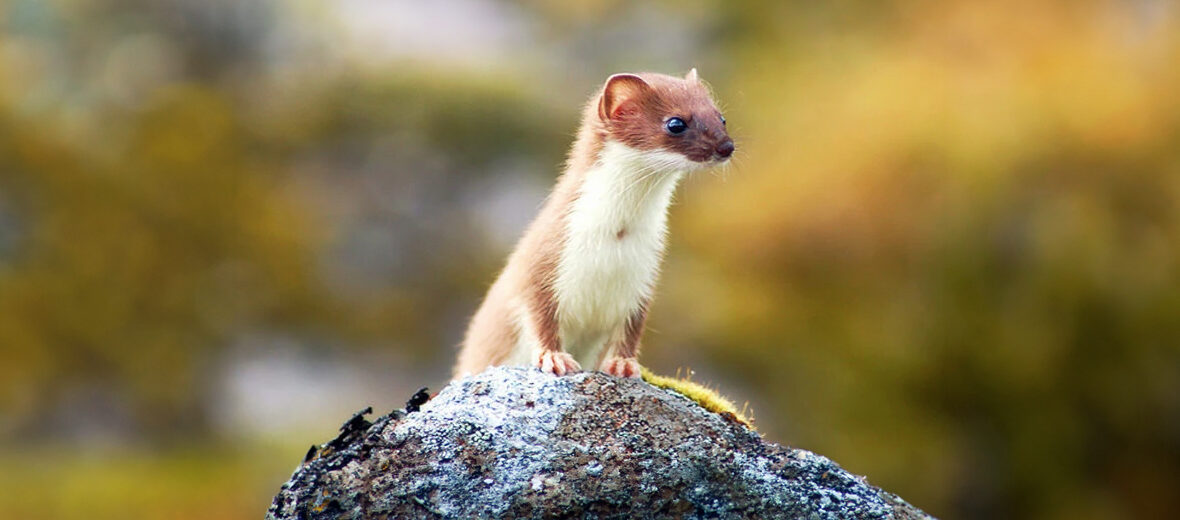
The least weasel, aka weasel, common weasel, or little weasel, is widespread through Canada, United States, Europe, Asia, and northern Africa. They have also been introduced to the Azores, Crete, Malta, New Zealand, and São Tomé. They suffer the threats of habitat loss and destruction, as well as the threats of hunting and trapping. However, due to their widespread and abundant populations throughout the northern hemisphere these weasels are listed as Least Concern by the IUCN. Their population trend is stable.
First the Stats…
Scientific name: Mustela nivalis
Weight: Up to 8.8 ounces
Length: Up to 9.8 inches, plus up to a 3.4 inch tail
Lifespan: Up to 10 years
Now on to the Facts!
1.) There are 18 recognized subspecies of least weasels.
2.) They prey on mice, rats, voles, shrews, moles, lemmings, gerbils, pikas, rabbits, squirrels, birds, bird eggs, lizards, frogs, and fish.
3.) In turn least weasels are preyed on by a host of animals such as foxes, owls, hawks, eagles, dogs, cats, snakes, bobcats, buzzards, stoats, polecats, sables, and long-tailed weasels.
4.) Least weasels utilize existing burrows to take shelter and rear their young, rather than dig their own.
5.) Carl Linnaeus is credited for first documenting these critters in 1766 and gave them the name Mustela nivalis in the 12th edition of his book Systema Naturae.
But wait, there’s more on the least weasel!
6.) The epithet nivalis hails from the Latin word nix which translates to “snow” due to their white coat during the winter months.
7.) Breeding season lasts from April – July.
Did you know…?
The direct ancestor of these weasels was Mustela praenivalis, which dwelled in Europe during the Middle Pleistocene and Villafranchian epochs.
8.) Females undergo up to a 37 day gestation (pregnancy) that yields up to 6 kits.
9.) Kits are born altricial (blind, hairless, deaf, and completely helpless).
10.) The kit’s milk teeth break through at up to 3 weeks of age, at which time the young begin to eat solid food, though weaning can last up to 12 weeks.
But wait, there’s still more on the least weasel!
11.) It is highly likely that these weasels crossed to North America through the Bering land bridge some 200,000 years ago.
12.) Least weasels are divided into 3 categories of groups: boccamela group (large least weasels), nivalis group (medium-sized least weasels), and the pygmaea – rixosa group (small least weasels).
Did you know…?
Least weasels have been around for approximately 7 million years, when northern forests were replaced by open grassland, therefor prompting an explosive evolution of smaller, burrowing rodents.
13.) These critters have muscular anal glands under their tail, that measure 0.28 by 0.20 inches, and contain sulphurous volatiles such as dithiacyclopentanes and thietanes.
14.) The scent and chemical composition of these mentioned chemicals are different from those of the stoat.
15.) They move via a jumping motion, and the distance between the tracks of the fore and hind limbs are up to 13.8 inches.
But wait, there’s still a little more on the least weasel!
16.) Their winter fur is dense, soft, and silky but short and close fitting in northern species. In southern species the fur is coarse. Their summer fur is very short, rougher, and sparser.
17.) Least weasels prefer fields, open woodlands, rocky areas with shrubs, parks, and gardens at elevations of up to 9,800 feet.
Did you know…?
4 main vocalizations have been documented: a guttural hiss, screaming barks and/or shrieks, a shrill wail or squeal, and a high-pitched trilling.
18.) Males mark their territory via feces (poop) & urine, as well as via anal and dermal gland secretions that are deposited on surfaces by body rubbing and dragging.
19.) Burrows are shallow at only 6 inches below the surface.
20.) The nesting chamber is lined with straw and adorned with the skins of the weasel’s prey.
But wait, there’s but a little more on the least weasel!
21.) A dominant weasel will engage in lunges and shrieks during aggressive encounters, while a subdominant weasel will emit submissive squeals.
22.) In locations where the least weasel is sympatric (dwells in the same general area) with the stoat, the 2 species tend to compete with one another for rodent prey.
Did you know…?
When food is plentiful, only a small portion of their prey is eaten, typically just the brain.
23.) Ectoparasites (external parasites) known to infest weasels include the louse, various flea species, and 2 species of mites.
24.) Helminths (worms) that are known to infest weasels include the trematode Alaria, the nematodes Capillaria, Filaroides and Trichinella, and the cestode Taenia.
25.) In some areas of Macedon, women who suffered from headaches after having washed their heads in water drawn overnight assumed that a weasel had previously used the water as a mirror, but they would abstain from mentioning the animal’s name for fear that it would destroy their clothes.
26.) Least weasels are nocturnal (active at night).
Now a Short Least Weasel Video!
Be sure to share & comment below! Also, check out the Critter Science YouTube channel. Videos added regularly!
Want to suggest a critter for me to write about? Let me know here.
Some source material acquired from: Wikipedia & IUCN
Photo credit: Fandom




